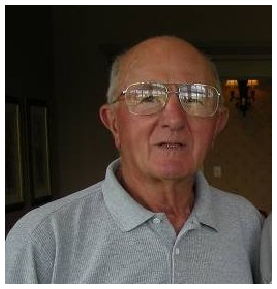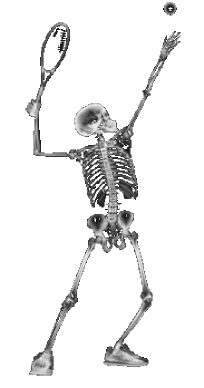October 2006 Article Wild Cards Archives:
Tennis Server
|

 |
by Tony Severino Certified Instructor 4A Professional Tennis Registry
Remember this classic?
How about this one?
"Every little movement has a meaning all its' own." What's has this to do with tennis? Let's take a look. You need a swing - not any swing, but that swing, a coordinated sequencing of all those body's areas that make up the kinetic chain. If you don't have that kind of swing, then it don't mean a thing.
Recognize this person on the right? That's you! Honest! Check out the parts: feet, knees, trunk, shoulders, elbow and wrist. It's you! It's me! Those are the links in the body's Kinetic Chain.: feet, knees, trunk, shoulders, elbow and wrist. Every little movement of each link in turn adds an impact on the total power output of your stroke. The Germans have a word for it: Gestalt, meaning more than the sum total of the parts. The process is nicely described in the USTA Newsletter for Tennis Coaches, "High-Performance Coaching" by Todd S. Ellenbecker, Chairman of the Sports Science Committee. We took the liberty of editing it somewhat. "The force generated by one link in the chain is transferred successively to the next link. The most effective tennis strokes begin with legs generating reaction from the ground which is transferred up the links of the kinetic chain to the racquet." "The coordinated timing of these body movements transfers the energy up through the body, moving from one body link to the next. Each movement in sequence builds upon the previous movement and contributes to the generation of racquet speed." Well said. In the serve, for instance, the action begins with the firm planting of the feet and the coiling of the body, knees bent, hips and shoulders turn, toss arm going up, racquet arm starting back, stretching the muscles in the links. This is what "loading" is. With the toss going up the unloading begins as the body uncoils and accumulates the power generated in the kinetic chain which peaks at impact with the ball. In the serve it is estimated that 54 percent or more of your power comes from your feet in contact with the ground. This answers the question "Why bend the knees?" When you unbend your knees you really push your feet down against the ground. Isaac Newton had an apple to fall on his head which enabled him to figure out that for every action there is an opposite and equal reaction. Hence, pushing down against the ground results in an equal and opposite reaction that starts the flow up the kinetic chain towards the body's trunk. Your feet must be in contact with the ground to start the unloading process. The amount of energy put in at this point becomes 54 percent of the power realized at impact with the ball. The trunk (hips and back) turn in sequence, continuing that energy upward and forward toward the court area, adding power to the impact moment. The shoulders, already primed, uncoil adding the power of their rotation. The elbow flexes and sends the lower arm into the stroke. The wrist snaps as the final link in a coordinated process. There can be no pausing. It must be continuous. Actually your muscles bare a similarity to a rubber band. They have elasticity and stretch, but they also have resiliency, which means they want to return to their original state. After impact a deceleration action begins because an abrupt stop at this point could result in muscle damage. Certain muscles act as a braking mechanism during the follow thru of every stroke. Potential injuries can occur from poorly timed sequences or over energizing certain links out of sequence. If you are an aggressive player with an abrupt, jabbing stroke to add power, you could be in danger of hurting a muscle or two. This might be a good time to check out your swing, preferably with a pro. Get those little movements doing their kinetic thing and get your swing to mean what you want it to mean. Then you can reminisce with another great classic: "I've got Rhythm!" If you wish to provide a comment to the author of this Wild Cards column, please use this form. Tennis Server will forward the comment to the author.
1998 - 2003 | 2004 - Present
This column is copyrighted by the author, all rights reserved.
|



October 2022 Tennis Anyone: Patterns in Doubles by John Mills. September 2022 Tennis Anyone: Short Court by John Mills. |
 You will join 13,000 other subscribers in receiving news of updates to the Tennis Server along with monthly tennis tips from tennis pro Tom Veneziano.
You will join 13,000 other subscribers in receiving news of updates to the Tennis Server along with monthly tennis tips from tennis pro Tom Veneziano. 

 We're talking of course, about the body's Kinetic Chain and how each link in sequence adds its energy to a seemingly effortless, powerful tennis stroke.
We're talking of course, about the body's Kinetic Chain and how each link in sequence adds its energy to a seemingly effortless, powerful tennis stroke.